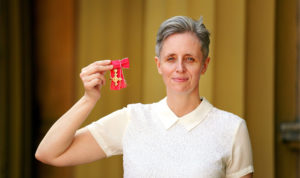Once upon a time, pollsters would phone you up and ask how satisfied you were with the railways on a scale of one to ten, or how you intended to vote in the next general election. These days — as in the UnHerd Britain poll, published today — you might equally be asked to pronounce on the deep metaphysics of womanhood. And indeed, on that most vexed of contemporary scholastic questions, namely whether “trans women are women”, it seems the jury is still out. According to the poll, 33% of us agree, 33% disagree, and 34% do neither.
Perhaps puzzlingly, this is despite the fact that, faced with practical questions about women’s spaces and women’s sports, there seems to be significant agreement that trans women should keep out of both. Had the latter results been the only ones revealed today, they surely would have suggested that, when push comes to shove, most people do not believe that trans women are women. For the alternative doesn’t add up: large sections of the British public believe there is a kind of anomalously shaped, baritone-voiced woman out there who also, for some reason, shouldn’t be allowed in a female changing room or on the sports field with other women.
A similar impression of confusion in the public mind emerges when the answers to two further poll questions are compared. A majority of respondents agreed that “people should be able to identify as being of a different gender to the one they had recorded at birth”. However, there was markedly less enthusiasm for making it easier to change “legal gender”. This too looks like a strange juxtaposition, at least at first.
In this case, though, the disparity is presumably explained by the fact that “to identify as being of a different gender” in the first question has been interpreted by respondents as nothing much more meaningful than donning fancy dress. To “identify” here mainly refers to men saying that they feel like women, and women saying that they feel like men (or at least, don’t feel like women) — perhaps with some non-conforming clothing thrown in for good measure. It would be an illiberal state indeed that tried to outlaw any of this, and at odds with our generally tolerant national character to try. Still, for poll respondents, rightly allowing people to express themselves freely doesn’t seem to have entailed that we should start handing out gender recognition certificates on the strength of it.
Yet the “trans women are women” answer remains an intriguing one. To my mind, the fact that 34% neither agree nor disagree is telling. And I don’t blame people for feeling befuddled. Pollsters inherit the limitations of dominant public ways of framing particular issues — and there is no more confusing framing than “trans women are women”. For a start, there’s the fact that the phrase functions like a mantra. As transactivists who frequently deploy the phrase no doubt realise, the repetition of the word “women” produces a slightly hypnotic effect. After all, it looks tautological — a bit like asking whether sausage dogs are dogs, or armchairs are chairs.
More fundamentally, there’s a widespread lack of clarity about who counts as a “trans woman” — a characteristic starkly exhibited in recent days by Scotland’s First Transactivist, Nicola Sturgeon. Is a trans woman someone who has had surgery to remove penis and testicles, and had a simulacrum of a vagina put there instead? Does being a trans woman require you to have taken artificial oestrogen for years, or to have had your natal testosterone suppressed? Do you have to own a gender recognition certificate?
Or does the category include men who don’t have any special legal status, and who only cross-dress, and perhaps don’t even bother doing that? Does it include convicted rapists who suddenly find a feeling of womanhood welling up within their bosoms on the way to a sentencing hearing? The more confusion there is about who counts as a trans woman, the less likely it is that people will be able to answer whether a trans woman is a woman or not with any certainty.
Whatever the source of the public’s confusion, it’s a testament to the dogged persistence of the LGBT+ lobbying sector that there is meaningful disagreement about the matter at all. For however you look at the polling, it still suggests that a significant proportion of the general population now think adult human males can change their sex by some kind of behavioural process — whether that’s a medical, legal, or merely sartorial one, or even just muttering “I’m a woman now” to your lawyer as the prospect of a male prison looms.
This bizarre epistemic situation did not arise on its own. Lamentable as the national standard of secondary school biology probably is, it still seems unlikely that many of us have mixed up human beings with sequential hermaphrodites. Clownfish, for instance, really can change their sex, going from the production of eggs to sperm over the course of a single lifetime. But — not to put too fine a point on it — humans aren’t fish.
And nor, I think, should we pay any attention to academics coughing and spluttering about the supposedly well-understood distinction between “sex” and “gender”. According to some of them, when someone says that a trans woman is a woman, they are not talking about adult human females at all. Rather, the speaker has accurately grasped something much more intellectually sophisticated — that womanhood is a “gender”, which some adult human males can come to possess, and some adult human females can shed.
The makers of this point conveniently ignore the fact that “gender” is used in multiple ambiguous ways these days, including as a polite synonym for biological sex, and alternatively as a name for a set of social stereotypes for femininity and masculinity. If you ask these same academics if they mean that womanhood is a matter of liking pink glittery things and tottering about on high heels, they get quite cross. And if you ask them to further explain what they think womanhood is then, if not conforming to sexist stereotypes, they may try to get you fired from your job. Either way, the idea that the general public is motivated by a deep comprehension of gender studies arcana seems to me somewhat optimistic.
So really, the victory here — if it can be called that — belongs almost entirely to organisations such as Stonewall, Mermaids, Gendered Intelligence, All About Trans, the Scottish Equality Network, and associated pals in the rainbow-hued phalanx. You really do have to hand it to them. Quite astonishingly, they have turned what used to be a boringly factual matter about whether Xs were Ys into a quasi-religious question revealing the respondent’s personal values. And at least to some extent, it has clearly worked.
Collaborating together over a decade, these organisations have poured resources — donated to them by well-meaning foundations, generous lottery distributors, and successive Tory governments — into guilt-tripping much of the nation into half-believing something nonsensical. A quick search of charity databases over the last decade shows tens of millions of pounds specially dedicated to trans projects — including many for “trans kids”. Such projects tend to heartrendingly represent trans people as a uniquely martyred class, especially vulnerable to threat and so in need of various kinds of support, resources, and encouragement to compensate. First among concessions demanded on their behalf has been that personal fictions of sex-change be validated by the world. It’s been presented as the very least we could do.
For years then, under the guise of equality, lobbyists have been spinning this line in UK workplaces, youth groups, schools, universities, hospitals, media outlets, government departments, police forces, local councils, and so on — and yes, in prison services too. They have relentlessly insisted that the question “are trans women, women?” is a test of individual character rather than a basic request for information. According to their imposed logic, “strongly agree” correlates with “minimally compassionate”, and “strongly disagree” correlates with “genocidal”. It’s as if the public has been sold a subliminal version of the Peter Pan story: say you believe that fairies exist, and you can save Tinkerbell from dying.
Meanwhile, for most for this same period, the British media has failed in its basic duty to investigate LGBT+ propaganda properly, much of the time simply passing it along to readers unexpurgated, as if doing PR. Even now, if your main news source is The Guardian or the BBC you will be lucky to have come across such complicating facts as, say, that around 60% of trans women in UK prisons are sex offenders; or that the starkly rising rates of rape among “women” may not be what they seem; or that murder rates of trans people in the UK are gratifyingly extremely low, and for the last few years non-existent. The story of the martyred UK trans woman continues to flourish, as does the moral pressure to try to keep her alive by saying the right words. Small wonder, then, that people still seem confused.
Depressing as this might appear, perhaps we shouldn’t despair. Poll results from Scotland in particular suggest that, however vague people seem to be about theoretical questions, when confronted by the practical consequences of treating a trans woman as a woman, thoughts get suddenly and quickly clarified. With the debacle of the Scottish Prison Service’s putting male sex offenders in the female estate perhaps freshly in mind, nine out of the ten constituencies most strongly opposed to allowing trans women in women’s spaces were Scottish. And this doesn’t feel like a coincidence.
Relatedly, perhaps we should also consider that what people sometimes say might not actually be that good an indication of what they really believe. Many philosophers think that the content of a person’s beliefs should not be identified only in terms of individual things he says. Rather, his beliefs should be gauged in relation to how his statements more generally fit together with his behaviour and other expressed thoughts (or do not). For instance, someone who says she believes that the sky is falling in, but who doesn’t duck or otherwise mention it in other relevant contexts, is perhaps not being entirely reliable.
Equally, someone who in one context seems tempted by the thought that trans women are women, but who in another is clear that they don’t belong in women’s spaces or sports, perhaps doesn’t really believe that trans women are really women in the first place, no matter what she says directly on the matter. In that case, what the polling from Scotland may be telling us — at least, reading between the lines — is that for many north of the border, trans women are in fact men. When confronted with the evidence of eyes and ears, the decade-long guilt-trip is apparently running out of steam.
Disclaimer
Some of the posts we share are controversial and we do not necessarily agree with them in the whole extend. Sometimes we agree with the content or part of it but we do not agree with the narration or language. Nevertheless we find them somehow interesting, valuable and/or informative or we share them, because we strongly believe in freedom of speech, free press and journalism. We strongly encourage you to have a critical approach to all the content, do your own research and analysis to build your own opinion.
We would be glad to have your feedback.
Source: UnHerd Read the original article here: https://unherd.com/




